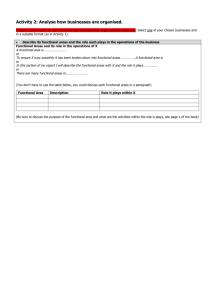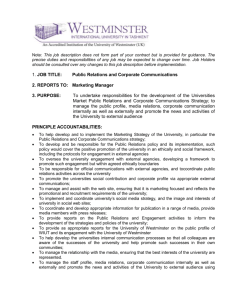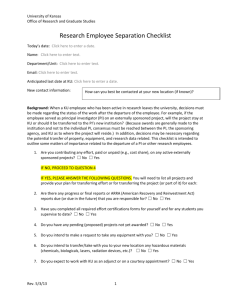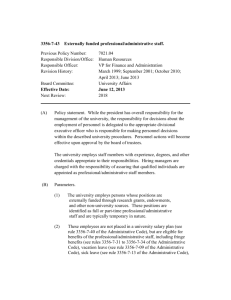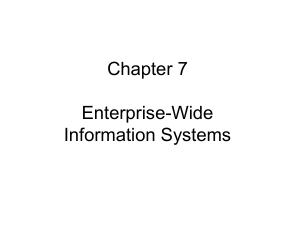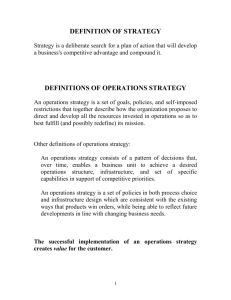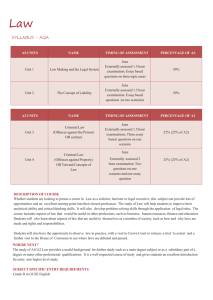Document
advertisement
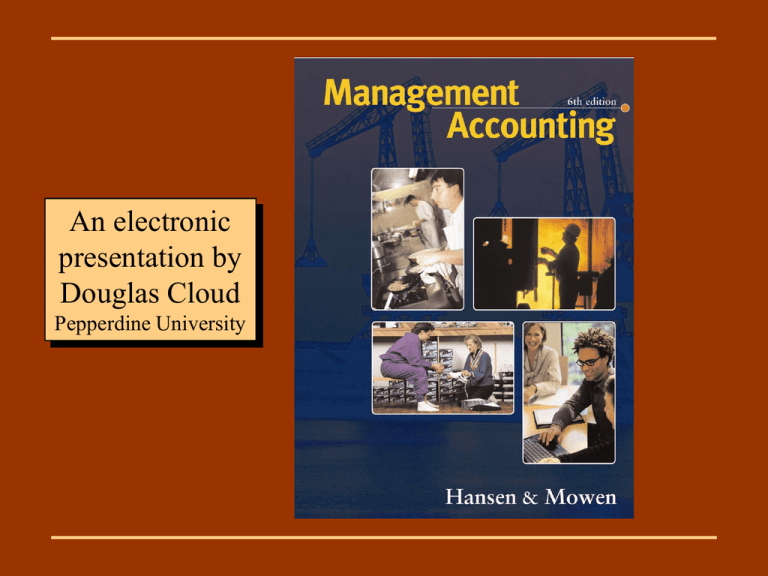
1 -1 An electronic presentation by Douglas Cloud Pepperdine University 1 -2 Task Force Clip Art included in this electronic presentation is used with the permission of New Vision Technology of Nepean Ontario, Canada. 1 -3 CHAPTER Introduction: The Role, History, and Direction of Management Accounting 1 -4 Objectives 1. Discuss the need for management accounting After studying this information. chapter, you should 2. Differentiate between management accounting be able to: and financial accounting. 3. Provide a brief historical description of management accounting. 4. Identify the current focus of management accounting. Continued 1 -5 Objectives 5. Describe the role of management accountants in an organization. 6. Explain the importance of ethical behavior for managers and management accountants. 7. List three forms of certification available to management accountants. 1 -6 The managerial accounting system has three broad objectives: 1. To provide information for costing out services, products, and other objects of interest to management. 2. To provide information for planning, controlling, evaluating, and continuous improvement. 3. To provide information for decision making. 1 -7 Management Accounting Information System Economic Events Collecting Measuring Storing Analyzing Reporting Managing Special Reports Product Costs Customer Costs Budgets Performance Reports Personal Communication Inputs Processes Outputs Users 1 -8 Management Process The Management Process is defined by the following activities: Planning Controlling Decision Making Planning requires setting objectives and identifying methods to achieve those objectives. 1 -9 Management Process The Management Process is defined by the following activities: Controlling is Planning Controlling Decision Making the managerial activity of monitoring a plan’s implementation and taking corrective action as needed. 1 -10 Management Process The Management Process is defined by the following activities: Planning Controlling Decision Making Control is usually achieved with the use of feedback. 1 -11 Management Process Feedback is information that can be used to evaluate or correct the steps being taken to implement a plan. 1 -12 Management Process The Management Process is defined by the following activities: Planning Controlling Decision Making Decision making is the process of choosing among competing alternatives. 1 -13 Differentiate Between Management Accounting and Financial Accounting Management Accounting 1. Internally focused Financial Accounting 1. Externally focused 1 -14 1 -15 Targeted Users Management accounting focuses on providing information for internal users. 1 -16 Targeted Users ABC Company Annual Report Financial accounting focuses on provided information for external users. Management Accounting 1. Internally focused 2. No mandatory rules Financial Accounting 1 -17 1. Externally focused 2. Must follow externally imposed rules 1 -18 Restrictions on Inputs and Processes Management accounting is not subject Financial accounting reporting must to the of generally follow therequirements accounting procedures set by accepted accounting principles. the SEC and the FASB. Management Accounting 1. Internally focused 2. No mandatory rules 3. Financial and nonfinancial information; subjective information possible Financial Accounting 1 -19 1. Externally focused 2. Must follow externally imposed rules 3. Objective financial information 1 -20 Types of Information ForThe management restrictionsaccounting, imposed onthe financial financialaccounting or nonfinancial tend to produce information objective may be and much verifiable more financial subjective information. in nature. Management Accounting 1. Internally focused 2. No mandatory rules 3. Financial and nonfinancial information; subjective information possible 4. Emphasis on the future Financial Accounting 1 -21 1. Externally focused 2. Must follow externally imposed rules 3. Objective financial information 4. Historical orientation 1 -22 Time Orientation Management accounting strongly emphasizes providing information about future events. 1 -23 Time Orientation Financial accounting records and reports events that have already happened. Management Accounting 1. Internally focused 2. No mandatory rules 3. Financial and nonfinancial information; subjective information possible 4. Emphasis on the future 5. Internal evaluation and decisions based on very detail information Financial Accounting 1 -24 1. Externally focused 2. Must follow externally imposed rules 3. Objective financial information 4. Historical orientation 5. Information about the firm as a whole 1 -25 Degree of Aggregation Management accounting provides measures and internal reports used the evaluate performance of entities, product lines, departments, and managers. 1 -26 Degree of Aggregation Financial accounting focuses on overall firm performance. Management Accounting 1. Internally focused 2. No mandatory rules 3. Financial and nonfinancial information; subjective information possible 4. Emphasis on the future 5. Internal evaluation and decisions based on very detail information 6. Broad, multidisciplinary Financial Accounting 1 -27 1. Externally focused 2. Must follow externally imposed rules 3. Objective financial information 4. Historical orientation 5. Information about the firm as a whole 6. More self-contained 1 -28 Breadth It includes aspects of managerial Management accounting is much economics, industrial engineering, broader than financial accounting. and management science. Historical Description of Management Accounting 1880 - 1925 Most of the product-costing and internal accounting procedures used in this century were developed 1925 Emphasis of inventory costing for external reporting 1950s/60s Effort to improve the managerial usefulness of traditional cost systems 1980s/90s Significant efforts have been made to radically change the nature and practice of management accounting 1 -29 1 -30 Current Focus of Management Accounting Activity-Based Management Activity-based management is a system wide, integrated approach that focuses management’s attention on activities with the objective of improving customer value and the resulting profit. 1 -31 Current Focus of Management Accounting Customer Orientation Customer value is the difference between what the customer receives (customer satisfaction) and what the customer gives up (customer sacrifice). What is received is called the total product. 1 -32 Current Focus of Management Accounting Strategic Positioning Strategic cost management is the use of cost data to develop and identify superior strategies that will produce a sustainable competitive advantage. Strategies: 1) Cost leadership 2) Superior products through differentiation 1 -33 Current Focus of Management Accounting Value-Chain Framework The internal value chain is the set of activities required to design, develop, produce, market, and deliver products and services to customers. The industrial value chain is the linked set of value-creating activities from basic raw materials to the disposal to the final products by end-use customers. 1 -34 Planting and Cultivating Value Chain: Apple Industry Harvesting Firm B Distribution of Apples Firm A Applesauce Production Product Disposal Applesauce Distribution End-Use Customer Supermarkets Firm C 1 -35 Managing the value chain means that a management accountant must understand many functions of the business, from manufacturing to marketing. 1 -36 This emphasis on quality has created a demand for management The philosophy of total quality accounting systems that provide management is to manufacture financial and nonfinancial perfect products. information about quality. 1 -37 The role of management accountants in an organization is one of support. Partial Organization Chart, Manufacturing Company 1 -38 President Line Function Staff Function Production Vice President Financial Vice President Production Supervisor Machining Foreman Assembly Foreman Controller Internal Audit Cost Financial Treasurer Systems Ta x 1 -39 Ethical Behavior Michael Josephson’s* Ten Ethical Values: Honesty Caring for others Integrity Respect for others Promise keeping Fidelity Responsible citizenship Fairness Pursuit of excellence Accountability *Michael Josephson, “Teaching Ethical Decision Making and Principled Reasoning” 1 -40 Professional Certifications CMA: One of the main purposes of the CMA was to establish management accounting as a recognized, professional discipline, separate from the profession of public accounting. CPA: The responsibility of a CPA is to provide assurance concerning the reliability of financial statements. CIA: The focus of the CIA is to recognize competency in internal auditing rather than external auditing as with the CPA. 1 -41 The CMA Four areas emphasized on the exam: 1) Economics, finance, and management 2) Financial accounting and reporting 3) Management report, analysis, and behavioral issues 4) Decision analysis and information systems 1 -42 Chapter One The End 1 -43
